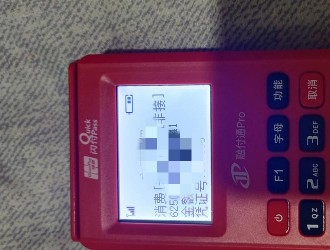网上有很多关于响应式pos机源码,ffplay源码分析06 的知识,也有很多人为大家解答关于响应式pos机源码的问题,今天pos机之家(www.poszjia.com)为大家整理了关于这方面的知识,让我们一起来看下吧!
本文目录一览:
响应式pos机源码
初始化
View Code
初始化主要在main里面,主要做了如下几件事:
1. SDL_Init,主要是SDL_INIT_VIDEO的⽀持2. SDL_CreateWindow,创建主窗⼝3. SDL_CreateRender,基于主窗⼝创建renderer,⽤于渲染输出。4. stream_open5. event_loop,播放控制事件响应循环,但也负责了video显示输出。
video_refresh()
/* called to display each frame *//* 非暂停或强制刷新的时候,循环调用video_refresh */static void video_refresh(void *opaque, double *remaining_time){ VideoState *is = opaque; double time; Frame *sp, *sp2; if (!is->paused && get_master_sync_type(is) == AV_SYNC_EXTERNAL_CLOCK && is->realtime) check_external_clock_speed(is); if (!display_disable && is->show_mode != SHOW_MODE_VIDEO && is->audio_st) { time = av_gettime_relative() / 1000000.0; if (is->force_refresh || is->last_vis_time + rdftspeed < time) { video_display(is); is->last_vis_time = time; } *remaining_time = FFMIN(*remaining_time, is->last_vis_time + rdftspeed - time); } if (is->video_st) {retry: if (frame_queue_nb_remaining(&is->pictq) == 0) {// 帧队列是否为空 // nothing to do, no picture to display in the queue // 什么都不做,队列中没有图像可显示 } else { // 重点是音视频同步 double last_duration, duration, delay; Frame *vp, *lastvp; /* dequeue the picture */ // 从队列取出上一个Frame lastvp = frame_queue_peek_last(&is->pictq);//读取上一帧 vp = frame_queue_peek(&is->pictq); // 读取待显示帧 // lastvp 上一帧(正在显示的帧) // vp 等待显示的帧 if (vp->serial != is->videoq.serial) { // 如果不是最新的播放序列,则将其出队列,以尽快读取最新序列的帧 frame_queue_next(&is->pictq); goto retry; } if (lastvp->serial != vp->serial) { // 新的播放序列重置当前时间 is->frame_timer = av_gettime_relative() / 1000000.0; } if (is->paused) { goto display; printf("视频暂停is->paused"); } /* compute nominal last_duration */ //lastvp上一帧,vp当前帧 ,nextvp下一帧 //last_duration 计算上一帧应显示的时长 last_duration = vp_duration(is, lastvp, vp); // 经过compute_target_delay方法,计算出待显示帧vp需要等待的时间 // 如果以video同步,则delay直接等于last_duration。 // 如果以audio或外部时钟同步,则需要比对主时钟调整待显示帧vp要等待的时间。 delay = compute_target_delay(last_duration, is); time= av_gettime_relative()/1000000.0; // is->frame_timer 实际上就是上一帧lastvp的播放时间, // is->frame_timer + delay 是待显示帧vp该播放的时间 if (time < is->frame_timer + delay) { //判断是否继续显示上一帧 // 当前系统时刻还未到达上一帧的结束时刻,那么还应该继续显示上一帧。 // 计算出最小等待时间 *remaining_time = FFMIN(is->frame_timer + delay - time, *remaining_time); goto display; } // 走到这一步,说明已经到了或过了该显示的时间,待显示帧vp的状态变更为当前要显示的帧 is->frame_timer += delay; // 更新当前帧播放的时间 if (delay > 0 && time - is->frame_timer > AV_SYNC_THRESHOLD_MAX) { is->frame_timer = time; //如果和系统时间差距太大,就纠正为系统时间 } SDL_LockMutex(is->pictq.mutex); if (!isnan(vp->pts)) update_video_pts(is, vp->pts, vp->pos, vp->serial); // 更新video时钟 SDL_UnlockMutex(is->pictq.mutex); //丢帧逻辑 if (frame_queue_nb_remaining(&is->pictq) > 1) {//有nextvp才会检测是否该丢帧 Frame *nextvp = frame_queue_peek_next(&is->pictq); duration = vp_duration(is, vp, nextvp); if(!is->step // 非逐帧模式才检测是否需要丢帧 is->step==1 为逐帧播放 && (framedrop>0 || // cpu解帧过慢 (framedrop && get_master_sync_type(is) != AV_SYNC_VIDEO_MASTER)) // 非视频同步方式 && time > is->frame_timer + duration // 确实落后了一帧数据 ) { printf("%s(%d) dif:%lfs, drop frame\", __FUNCTION__, __LINE__, (is->frame_timer + duration) - time); is->frame_drops_late++; // 统计丢帧情况 frame_queue_next(&is->pictq); // 这里实现真正的丢帧 //(这里不能直接while丢帧,因为很可能audio clock重新对时了,这样delay值需要重新计算) goto retry; //回到函数开始位置,继续重试 } } if (is->subtitle_st) { while (frame_queue_nb_remaining(&is->subpq) > 0) { sp = frame_queue_peek(&is->subpq); if (frame_queue_nb_remaining(&is->subpq) > 1) sp2 = frame_queue_peek_next(&is->subpq); else sp2 = NULL; if (sp->serial != is->subtitleq.serial || (is->vidclk.pts > (sp->pts + ((float) sp->sub.end_display_time / 1000))) || (sp2 && is->vidclk.pts > (sp2->pts + ((float) sp2->sub.start_display_time / 1000)))) { if (sp->uploaded) { int i; for (i = 0; i < sp->sub.num_rects; i++) { AVSubtitleRect *sub_rect = sp->sub.rects[i]; uint8_t *pixels; int pitch, j; if (!SDL_LockTexture(is->sub_texture, (SDL_Rect *)sub_rect, (void **)&pixels, &pitch)) { for (j = 0; j < sub_rect->h; j++, pixels += pitch) memset(pixels, 0, sub_rect->w << 2); SDL_UnlockTexture(is->sub_texture); } } } frame_queue_next(&is->subpq); } else { break; } } } frame_queue_next(&is->pictq); // 当前vp帧出队列 is->force_refresh = 1; /* 说明需要刷新视频帧 */ if (is->step && !is->paused) stream_toggle_pause(is); }display: /* display picture */ if (!display_disable && is->force_refresh && is->show_mode == SHOW_MODE_VIDEO && is->pictq.rindex_shown) video_display(is); // 重点是显示 } is->force_refresh = 0; if (show_status) { static int64_t last_time; int64_t cur_time; int aqsize, vqsize, sqsize; double av_diff; cur_time = av_gettime_relative(); if (!last_time || (cur_time - last_time) >= 30000) { aqsize = 0; vqsize = 0; sqsize = 0; if (is->audio_st) aqsize = is->audioq.size; if (is->video_st) vqsize = is->videoq.size; if (is->subtitle_st) sqsize = is->subtitleq.size; av_diff = 0; if (is->audio_st && is->video_st) av_diff = get_clock(&is->audclk) - get_clock(&is->vidclk); else if (is->video_st) av_diff = get_master_clock(is) - get_clock(&is->vidclk); else if (is->audio_st) av_diff = get_master_clock(is) - get_clock(&is->audclk); av_log(NULL, AV_LOG_INFO, "%7.2f %s:%7.3f fd=M aq=]KB vq=]KB sq=]B f=%"PRId64"/%"PRId64" \", get_master_clock(is), (is->audio_st && is->video_st) ? "A-V" : (is->video_st ? "M-V" : (is->audio_st ? "M-A" : " ")), av_diff, is->frame_drops_early + is->frame_drops_late, aqsize / 1024, vqsize / 1024, sqsize, is->video_st ? is->viddec.avctx->pts_correction_num_faulty_dts : 0, is->video_st ? is->viddec.avctx->pts_correction_num_faulty_pts : 0); fflush(stdout); last_time = cur_time; } }}
video_image_display()
static void video_image_display(VideoState *is){ Frame *vp; Frame *sp = NULL; SDL_Rect rect; // keep_last的作用就出来了,我们是有调用frame_queue_next, 但最近出队列的帧并没有真正销毁 // 所以这里可以读取出来显示 vp = frame_queue_peek_last(&is->pictq); if (is->subtitle_st) { if (frame_queue_nb_remaining(&is->subpq) > 0) { sp = frame_queue_peek(&is->subpq); if (vp->pts >= sp->pts + ((float) sp->sub.start_display_time / 1000)) { if (!sp->uploaded) { uint8_t* pixels[4]; int pitch[4]; int i; if (!sp->width="360px",height="auto" />
convert_ctx = sws_getCachedContext(is->sub_convert_ctx, sub_rect->w, sub_rect->h, AV_PIX_FMT_PAL8, sub_rect->w, sub_rect->h, AV_PIX_FMT_BGRA, 0, NULL, NULL, NULL); if (!is->sub_convert_ctx) { av_log(NULL, AV_LOG_FATAL, "Cannot initialize the conversion context\"); return; } if (!SDL_LockTexture(is->sub_texture, (SDL_Rect *)sub_rect, (void **)pixels, pitch)) { sws_scale(is->sub_convert_ctx, (const uint8_t * const *)sub_rect->data, sub_rect->linesize, 0, sub_rect->h, pixels, pitch); SDL_UnlockTexture(is->sub_texture); } } sp->uploaded = 1; } } else sp = NULL; } } //将帧宽高按照sar最大适配到窗口,并通过rect返回视频帧在窗口的显示位置和宽高 calculate_display_rect(&rect, is->xleft, is->ytop, is->width="360px",height="auto" />以上就是关于响应式pos机源码,ffplay源码分析06 的知识,后面我们会继续为大家整理关于响应式pos机源码的知识,希望能够帮助到大家!









